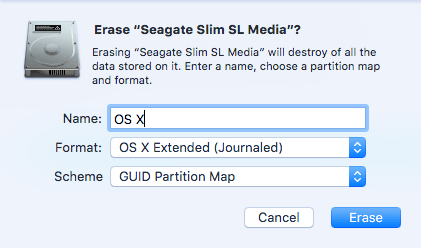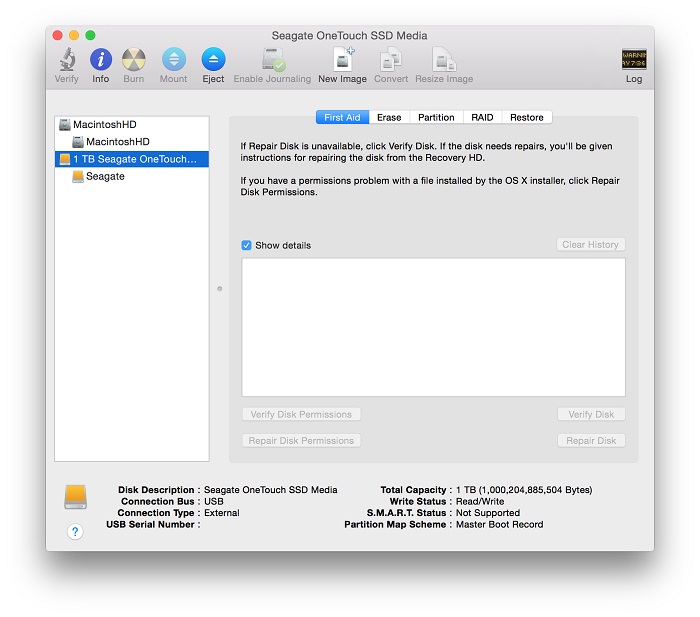
- #How to format hard drive mac os extended journaled how to#
- #How to format hard drive mac os extended journaled for mac#
- #How to format hard drive mac os extended journaled mac os#
- #How to format hard drive mac os extended journaled download#
- #How to format hard drive mac os extended journaled windows#
It’s important to keep in mind that if you run the eraseDisk command, the target disk is going to lose all its data, so make sure you are erasing the proper disk. The syntax is going to look like this: Diskutil eraseDisk JHFS+ Empty /dev/disk5s2
#How to format hard drive mac os extended journaled mac os#
Let’s say the disk I want to erase has “/dev/disk5s2” as its identifier and I’m going to use Mac OS Extended Journaled (JHFS+) as the system format type and name it “Empty”. This is the syntax we need: Diskutil eraseDisk FILESYSTEM DISKNAME DISKIDENTIFIER Then pick a name and a system format type. Once you have found the proper drive to erase, just copy its identifier so you can use it for the next command. This is going to list all the mounted drives on your Mac. Start off by running the following command in the command line: Diskutil list Here I'll show you how you can erase and format a disk using the command line. To do that, the only thing you need is a bit of precise syntax to make sure that you are erasing the proper disk. But some Mac users might need to erase them from the command line on Mac OS. Or, in macOS High Sierra and newer OS, you can choose to format your drive to APFS.Most users use Disk Utility to erase a disk or hard drive. If you want to format a hard drive, it's better to choose Mac OS Extended. When you need to format a USB drive or an SD card, the ExFAT is a better choice. Simply speaking, these two formats are both compatible with macOS. That's all about ExFAT and Mac OS Extended. Click Erase and wait for the process to be finished. Choose the proper format according to your device. Step 3. Now there would be a pop-up window, notice you enter your drive's name and file system format. Step 2. Find and select your drive from the left side. Step 1. Connect your external hard drive to your Mac, and go to Disk Utility.
#How to format hard drive mac os extended journaled how to#
How do I make my external hard drive compatible with Mac and PC How to format an external drive in OS X Select the drive you want to format.

Here are the steps of how to format a drive in Disk Utility. Mac Since Mac OS 8.1, the Mac has been using a format called HFS+ also known as Mac OS Extended format. With this tool, you can mount, erase, and format any external hard drive. On Mac computers, there is a built-in disk management tool called Disk Utility. How to Format External Hard Drives on Mac When formatting an external hard drive, like HDD or SSD, the recommended format is Mac OS Extended, furthermore, you need to choose Mac OS Extended (Journaled). If your SD card is 64GB or larger, choose ExFAT, if it's 32GB or less, choose MS-DOS (FAT). If you need to format a USB drive or an SD card, the recommended formats are ExFAT and FAT32. You can format your SD card or hard drive according to the following advice. In fact, there is no good or bad of these two file systems, they are just suited for different devices. Which One to Choose: ExFAT or Mac OS Extended?
#How to format hard drive mac os extended journaled windows#
In conclusion, exFAT is a file system that is compatible with both Windows and macOS, and it has no transfer file size limit. Like NTFS, exFAT has a larger limit on file and partition sizes, so you can store and transfer files larger than 4GB. The reason why to develop exFAT is to solve the problem that large files cannot be transferred in FAT32 format. However, its biggest disadvantage is that it does not support the transfer of files larger than 4GB, so most storage devices using this format are USB flash drives. When talking about exFAT, it is necessary for you to know FAT32.įAT32 is an old file system that is compatible with both Windows system and macOS, which is its biggest advantage. If you want to know their characteristics, please read on, we will introduce them in the following sections.ĮxFAT is short for extended file location table, it was introduced in 2006 and was added to older versions of Windows like Windows XP and Vista. They are less common than the two earlier-mentioned ones. In this article, we mainly help you distinguish between the two file system formats - exFAT and Mac OS Extended.
#How to format hard drive mac os extended journaled for mac#
According to Apple's introduction, APFS is the "default file system for Mac computers using macOS 10.13 or later, features strong encryption, space sharing, snapshots, fast directory sizing, and improved file system fundamentals." As for MS-DOS (FAT), it has a better-known name - FAT32. On a Mac computer or in macOS, there are four compatible file system formats: APFS, Mac OS Extended, MS-DOS (FAT), and exFAT. Also, they differ from each other in file names, file permissions, and other attributes. The main difference between all the file systems is how data is stored on the hard drive.

The file system is the way the system enables your storage device to store and arrange files.
#How to format hard drive mac os extended journaled download#
Download for Mac macOS 12.0 - 10.9 Also Available for Windows Overview of File System Format


 0 kommentar(er)
0 kommentar(er)
